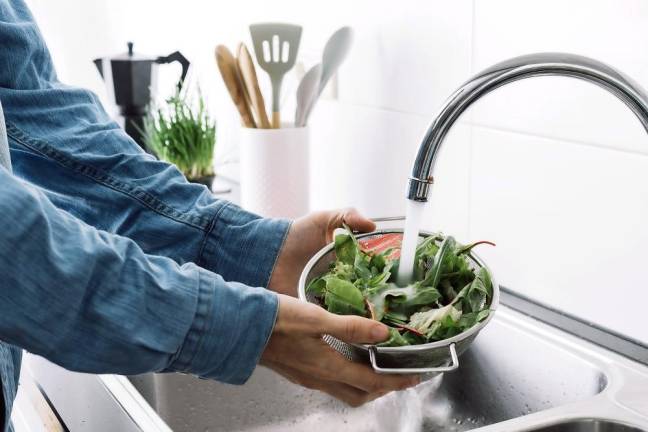Here's the best way to wash fruits and vegetables
Health. Recent outbreaks of food-borne illness have been linked to produce. Following these tips when preparing meals will keep your fruits and vegetables safe.

We know that eating a variety of fresh fruits and vegetables will keep us healthy, reducing the risk of some cancers and other diseases. Due to promotions such as the Produce for Better Health Foundation’s 5 A Day The Color Way campaign, people are encouraged to eat more fruits and vegetables as a part of their normal diet. This is good for public health.
On the other hand, news reports have linked salmonella and E. coli outbreaks with alfalfa and other sprouts. Fruits and vegetables are potential sources of food-borne illness because they are often eaten raw, without cooking to destroy pathogens.
According to the U.S. Food and Drug Administration, you should wash raw fruits and vegetables very well before you peel, cut, eat, or cook with them. Washing reduces the bacteria that may be present on fresh produce.
How to wash leafy greens
Leafy greens should be stored at 35 to 40°F within two hours of harvesting or purchasing.
Wash greens by separating leaves and soaking them in a bowl of cool water for a few minutes. Drain the greens using a strainer or colander and repeat this process. The goal here is dilution.
Another technique is to presoak greens for five minutes in a mixture of vinegar and water (1/2 cup distilled white vinegar per two cups water), which should be followed by a clean water rinse. This has been shown to reduce but not eliminate bacteria contamination, and it may slightly affect texture and taste.
Drain leafy greens with a clean strainer or colander, then dry with a clean towel or salad spinner. Salad spinners should be thoroughly cleaned with warm soapy water after every use.
Do commercial rinses work?
Chemical rinses and other treatments for washing raw produce — usually called fruit and vegetable washes — are now available to consumers. They are often advertised as the best way to keep fresh fruits and vegetables safe.
In the produce industry, chlorine is commonly used to remove microbes such as bacteria and mold. In the home, a water wash, either with or without the help of a produce brush, is typically used to clean fruits and vegetables. So how do water washes hold up against the commercial washes?
Researchers from the Department of Food Science and Human Nutrition at the University of Maine tested three commercial washes: Fit, made by Proctor & Gamble; Ozone Water Purifier XT-301, made by Air-Zone Inc.; and J0-4 Multi-Functional Food Sterilizer, made by Indoor Purification Systems.
All three products were tested according to product directions, with blueberries as the produce. A water wash was also tested, using blueberries soaked in distilled water for one to two minutes.
Fit washes got rid of roughly the same amount of microbes as distilled water, and both reduced the level of residual pesticides.
Both the Ozone Water Purifier XT-301 and the J0-4 Multi-Functional Food Sterilizer removed microbes from the blueberries. However, the distilled water wash was more effective than either of these ozone washes.
How to wash with water
The researchers advise consumers to wash fresh fruits and vegetables with distilled or bottled water, which has been filtered and purified to remove contaminants, or with very clean, cold tap water. Soak all produce for one to two minutes to reduce the risk of food-borne illness.
For produce with thick skin, use a vegetable brush to help wash away hard-to-remove microbes. Produce with a lot of nooks and crannies like cauliflower, broccoli or lettuce should be soaked for 1 to 2 minutes in cold clean water. Some produce, such as raspberries, should not be soaked. Put fragile produce in a colander and spray it with distilled water.
After washing, dry produce with clean paper towel. This can remove more bacteria.
Never wash produce with soaps or detergents. And don’t forget that homegrown and farmers market produce should also be well washed.
Developed by Jason Bolton, Alfred Bushway, Kristi Crowe, and Mahmoud El-Begearmi, University of Maine Department of Food Science and Human Nutrition, and Cooperative Extension (extension.umaine.edu).